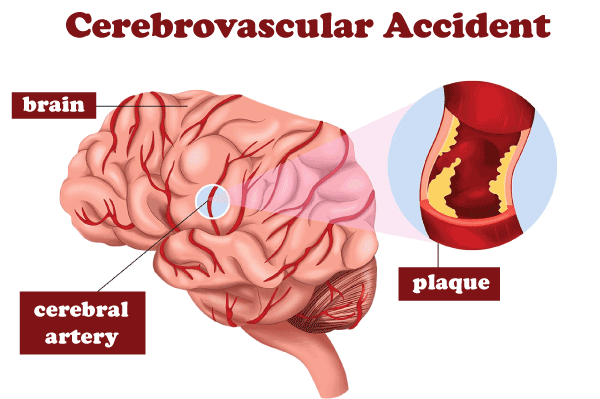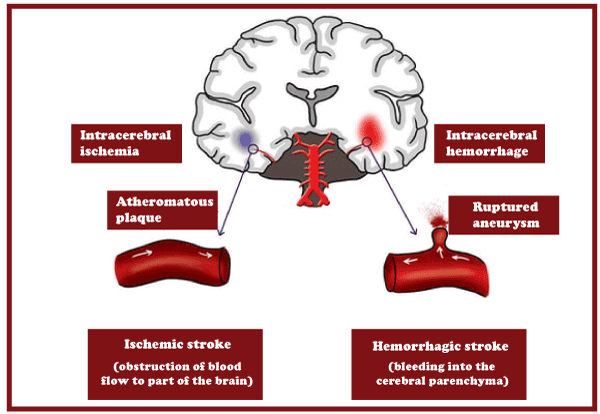What is the full form of CVA in Medical
CVA: Cerebrovascular Accident
CVA stands for Cerebrovascular Accident or Cerebral Vascular Attack. A stroke takes place when the flow to a part of your brain is interrupted due to a blockage or a blood vessel rupture.

CVA Types
There are 2 types of CVA or Strokes:
- Ischemic stroke
- Haemorrhagic stroke

Ischemic stroke: It is a stroke in which a blood clot blocks a blood vessel supplying blood to the brain. This clot can sometimes form within the body and circulate to become lodged in a blood vessel in the brain, or it may be formed in the brain. It is because of two conditions:
- A clot can be formed in an already narrow artery, It is known as a thrombotic stroke.
- A clot may form elsewhere in the brain's blood vessels or elsewhere in the body and travel to the brain, It is known as a cerebral embolism or an embolic stroke.
Haemorrhagic stroke: It is one in which blood vessels in the brain burst and blood rushes in under pressure, crushing neighbouring blood arteries and destroying brain cells. Since it is more difficult to prevent, the bleeding into the brain is more likely to cause death. Some people have defects in their brain which causes this type of stroke, and these defects can be concluded as follows:
- A weak area in the wall of a blood vessel causes the blood vessel to bulge.
- Abnormal connectivity between the arteries and veins.
- Another condition is amyloid angiopathy in which proteins called amyloid accumulate on the walls of the arteries in the brain.
Haemorrhagic strokes can also occur when taking blood thinners like warfarin. Sometimes an ischemic stroke can bleed and become a haemorrhagic stroke. Other significant risk factors include:
- Atrial fibrillation, which is also called irregular heartbeat.
- Diabetes
- High cholesterol in males
- Ageing, particularly after the age of 55
- Obesity
- Previous stroke or recent heart attack history
An increased risk of stroke exists in:
- People with a cardiac condition or reduced blood flow in their legs as a result of artery narrowing
- People with harmful lifestyle habits include smoking, binge drinking, using drugs recreationally, eating a high-fat diet, and not exercising.
- Females using birth control tablets after the age of 35.
- Pregnant women run a higher risk during pregnancy.
- Hormone replacement therapy users in women
Symptoms of a Stroke:
- Change of alertness (including sleepiness, unconsciousness, and coma)
- Hearing or taste modifications
- The ability to sense pressure, discomfort, or distinct temperatures changes
- Uncertainty or forgetfulness
- Swallowing difficulties
- Inability to read or write
- A strange moving sensation or dizziness (vertigo)
- Issues with vision, such as reduced eyesight, double vision, or complete blindness
- Uncontrollable bowels or a bladder
- Having problems walking or losing their coordination
- One particular side of the body has numbness
- Changes in character, attitude, or emotions
- Difficulty to communicate or understand others when they talk
Diagnosis, Treatment and Prevention:
Diagnosis:
A few tests that can be useful for determining this condition are:
- Doctors might take some blood samples to check the blood clotting time, and sugar levels or to determine a particular infection.
- An Angiogram can also be used which involves taking an X-ray of the head which can help the doctor to find the blocked blood vessel.
- A Carotid Ultrasound test might be conducted which uses sound waves to create images of the blood vessels in the neck and can help to determine if there's abnormal blood flow toward the brain.
- Another method is to perform a CT Scan test soon after the symptoms of stroke develop.
- An Echocardiogram can also be used which uses sound waves to generate a clear picture of the heart.
Treatment
A quick and immediate treatment involves the following:
- At the first sign of a stroke, dial the local emergency number, or seek immediate medical attention.
- People experiencing stroke symptoms should seek medical assistance as soon as possible.
- If the stroke is the result of a blood clot, a clot-busting medication may be used to dissolve the clot immediately. This treatment must be initiated within 3 to 4 hours of the onset of symptoms for it to be effective. The sooner this treatment is initiated, the better the chances of success.
- Other hospital treatments are dependent on the cause of the stroke
Prevention
A number of measures can help prevent a stroke, including:
- A healthy weight and controlled blood pressure.
- Decrease the consumption of saturated fat.
- Lower intake of cholesterol.
- Avoid smoking
- Avoid excess consumption of alcohol
- More intake of fruits and vegetables
- Controlled Diabetes
|


 For Videos Join Our Youtube Channel: Join Now
For Videos Join Our Youtube Channel: Join Now










